You definitely know freshwater, marine, and brackish water aquariums, have you ever heard of blackwater aquariums? They are different from traditional aquariums. They are tanks with acidic water, featuring light tea or dark brown watercolors. If you know little about blackwater aquariums, do not hurry, just read on. Today’s article will discuss more about blackwater aquariums, like what is a blackwater aquarium, and how to set up one.
Content Table
What Is a Blackwater Aquarium
Blackwater aquariums, which look dirty and dark, always come in soft and acidic water. Correspondingly, it features lower levels of pH, sodium, magnesium, potassium, and calcium. On the opposite side of general aquariums with bright water, the colors of blackwater aquariums are commonly light tea or dark brown. Besides, leaf litter and decaying debris can be a great addition to blackwater aquariums. Both tannins in plant matter and humic substances in decaying organisms play a role in aquarium watercolors. Blackwater aquariums simulate fish’s natural habitat, which is beneficial to fish growth, health, and thriving.
Given below shows the benefits of blackwater aquariums for fish health. Essentially, composed of humis, humic acid, and fulvic acid, the humic substances in decaying organisms can directly affect fish health. Keep in mind – it is the humic substances that are helpful to fish health, not the tannins. Tannins are only great for water quality improvement and pH level reduction. Next, let’s take a quick look at the benefits of humic substances:
- Improve absorption of food
- Higher yields of healthier eggs and fry
- Better natural resistance to parasitic or fungal infections
- Heal faster after injury or infections
- Extend lifespan
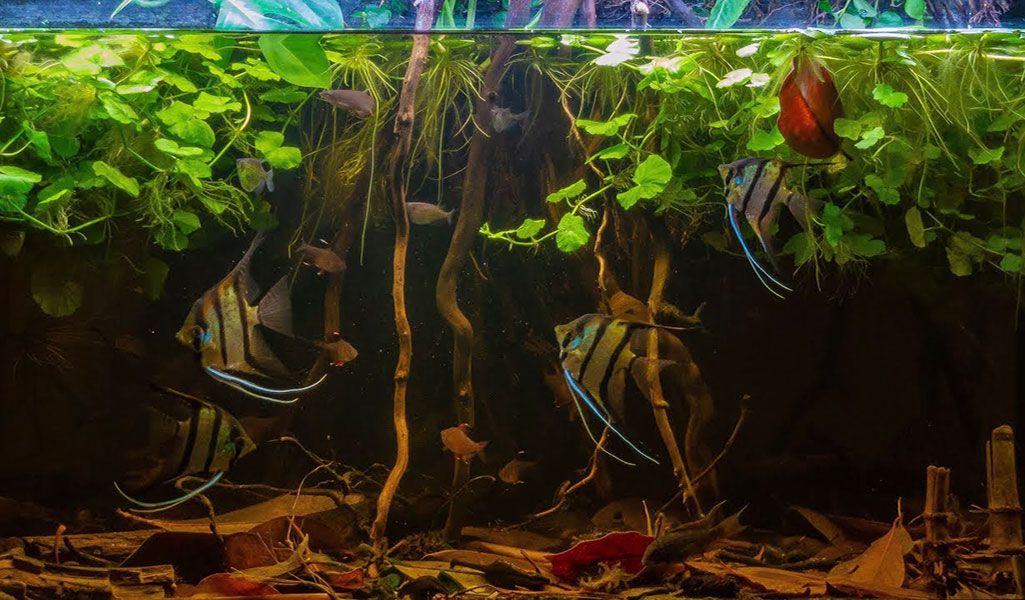
Great Choices for Blackwater Tanks
Aside from tannin sources to increase tannins in aquariums, you can also add some aquarium decors to improve the natural aesthetics, like leaf litter, rocks, etc. In this segment, let’s learn something about that.
1. Driftwood
Tannins would release from the bark of driftwood. And the aquarium water would turn into light tea or dark brown. Driftwood with dark colors is a great choice, like Malaysian driftwood and Mopani. However, driftwood that tends to rot quickly is not a good tannin source.
2. Leaf litter
Indian almond leaves, Malaysian mangroves, and Malaysian mulberry leaves are great options. The tannins from Indian almond leaves help decrease pH levels, inhibiting bacteria and fungus, eliminating parasites, as well as curing wounds and fin damage.
3. Other great material
Aside from all mentioned above, other available material includes:
- Cones: like Alder and Birch
- Seed pods
- Twigs or bark from safe-to-use wood
- Peat
- Commercial conditioners containing humic material
How to Make a Blackwater Aquarium
Blackwater aquarium set up
- Step one: Basic material preparation
In addition to the tannin sources mentioned in the last segment, there are other materials necessary, such as a fish tank, substrate, aquatic plants, aquarium light, aquarium heater, water test strips, etc.
- Step two: Add aquarium substrate, tannin sources, and decors
Add a layer of aquarium substrate, like sand or fine gravel. You should make sure the substrate is thick enough to plant aquatic plants. After that, it is feasible to place tannin sources and aquarium decors according to your needs. But, do not forget to leave sufficient room for plants and fish.
- Step three: Plant aquatic plants
Blackwater tanks are relatively darker and aquatic plants are not necessary for blackwater aquariums. But you can add some epiphyte plants, low-light plants, or floating plants, which can survive in a low-light environment. For instance, Anubias, Bucephalandra, Java fern, Java moss, Water Lettuce, and Frogbit. You can finish planting with the help of an aquarium aquascaping tools kit.
- Step four: Introduce fish
As long as the water parameters remain stable, you can introduce fish gradually. Commonly, it takes about 48–72 hours to cycle before adding fish to the tank.
Blackwater aquarium maintenance
(1)The frequency of replacing leaf litter
Exactly, how often should you replace leaf litter depends on the water flow rate and fish density. The higher the water flow rate and fish density, the shorter the time keeping leaf litter in the tank. In general, you can keep leaf litter in your tank for about 30–60 days. During the time frame, you can change the leaves according to the real-time tank status. If you need to change the leaf litter, it is better to remove half of the leaves at a time. Replacing all leaves at a time is not recommended.
(2)Build a great filtration system
- Mechanical filtration: It helps to filter debris, then your blackwater tank will not get clogged. Also, it can remove uneaten fish food, fish feces, aquatic plants’ leaf litter, etc. Decaying plant leaves are damaging to fish because it would increase the nitrate level in the tank.
- Biological filtration: It is helpful to grow beneficial bacteria, which can convert harmful substances into harmless ones. Like ammonia and nitrite.
- Chemical filtration: It makes sense to keep clean water. For example, it can remove excess medication after treatment.
(3)Other tips
- Observe your fish: You should observe your fish in daily life. Once you find abnormal symptoms, like loss of appetite and lethargy, you should find causes and treat the fish immediately.
- Test the water: Monitor the water parameters. You can test the water once a week. For example, test the water after water changes.
- Change water regularly: You can change water partially once each week. For instance, 20-50 percent of water.
Lighting for Blackwater Aquarium
Blackwater aquariums require dim light. As long as your aquarium light meets the needs of fish viewing and plants’ photosynthesis, then the light is suitable for blackwater aquariums. An aquarium light available for color spectrum adjustment is perfect, which enables you to optimize colors for fish and plants. Accordingly, a bluetooth clip on light is quite suitable, which allows you to freely set the RGB value and lumen of the light.
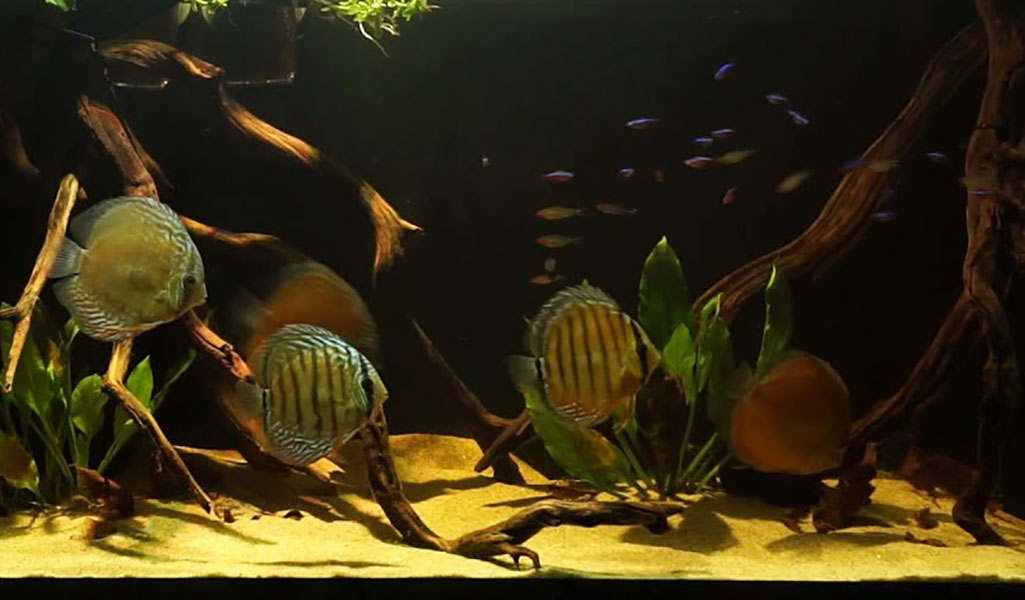
Best Fish for Blackwater Tank
Fish preferring acidic water can be excellent alternatives for blackwater tanks. However, fish that demand alkaline water should be avoided, like African cichlids. Next, we will list some best fish for blackwater tanks.
| Cardinal tetras | Plecos | Betta fish | Discus fish |
| Neon tetras | Angelfish | Gourami | Corydoras |
Take discus fish as an example, they prefer a pH level of 6.0 to 7.0, while the ideal pH level of cardinal tetras is 5.9 to 7.0. Both of them are tropical fish. Consequently, you can set up a 100-gallon blackwater tank with discus fish and cardinal tetras.
The Bottom Line
Until now, you know more about blackwater aquariums. But attention here, blackwater aquariums are different from brackish water aquariums. The latter features salty water in the aquarium. Also, the ideal pH level should be 7.8-8.4, while the alkalinity should be at 180-360 ppm (10-20 dKH). Furthermore, brackish water aquariums are ideal for keeping new aquatic species, such as Bumblebee goby, Mudskipper, and Green spotted puffer.

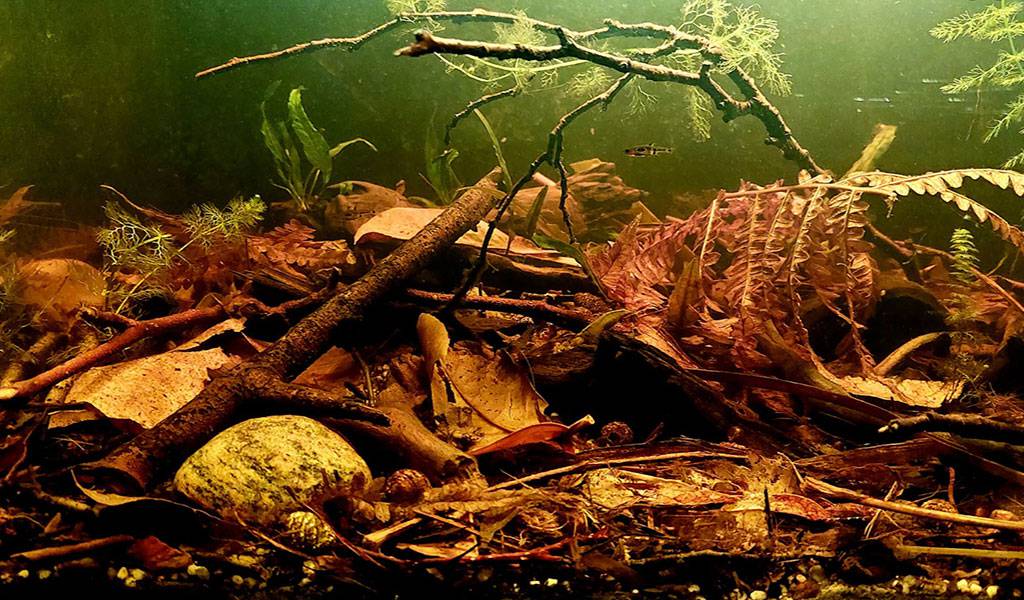
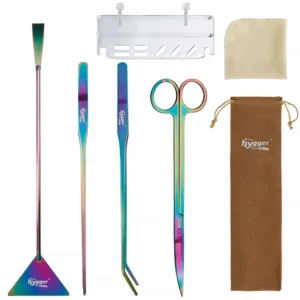
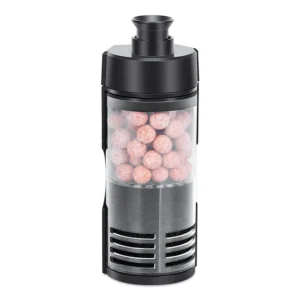
Leave a comment